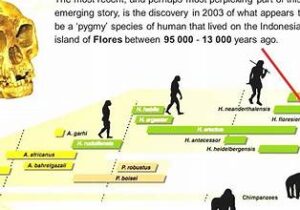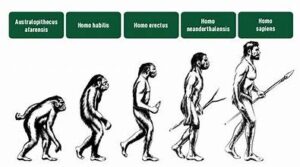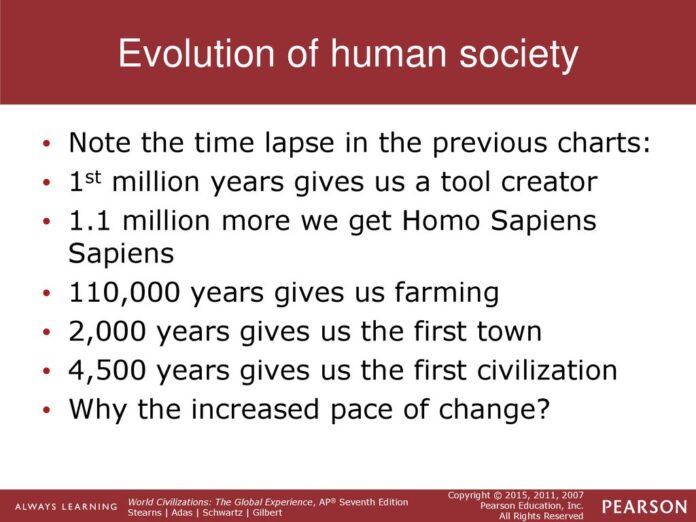
The evolution of human society is a fascinating journey that spans thousands of years, encompassing a wide array of cultural, technological, and social transformations. From the rudimentary beginnings of ancient civilizations to the complex, interconnected world of the digital age, humanity’s development is marked by several key milestones that have shaped the course of history.
The Dawn of Civilization: From Nomadic Tribes to Settled Communities
Human society began with small, nomadic tribes that lived off hunting, gathering, and basic tool-making. Around 12,000 years ago, a significant shift occurred with the advent of agriculture during the Neolithic Revolution. This period marked the transition from a nomadic lifestyle to settled communities. The ability to cultivate crops and domesticate animals allowed humans to form permanent settlements, leading to the rise of villages and eventually cities.
Agriculture brought about profound changes in human society. It enabled the production of surplus food, which in turn led to population growth and the development of complex social structures. With surplus food, not everyone had to be involved in food production, allowing some individuals to specialize in other areas such as craftsmanship, trade, and governance. This specialization laid the foundation for the first civilizations.
The Rise of Ancient Civilizations: Cradles of Culture and Innovation
The rise of ancient civilizations around 3,000 BCE marked another major milestone in the evolution of human society. In regions such as Mesopotamia, Egypt, the Indus Valley, and China, large, organized societies emerged, characterized by complex institutions, advanced technologies, and rich cultural traditions.
Mesopotamia, often referred to as the “cradle of civilization,” saw the development of writing, law, and urban planning. The Sumerians, one of the earliest civilizations in Mesopotamia, created cuneiform script, one of the first writing systems. This innovation allowed for the recording of transactions, laws, and stories, laying the groundwork for written history.
In Egypt, the construction of monumental architecture, such as the pyramids, demonstrated the Egyptians’ advanced knowledge of engineering and mathematics. The civilization also made significant contributions to art, medicine, and astronomy.
The Indus Valley civilization, known for its well-planned cities like Harappa and Mohenjo-Daro, excelled in urban planning, with sophisticated drainage systems and standardized weights and measures. Meanwhile, ancient China saw the rise of dynasties that would influence East Asia for millennia, introducing innovations like papermaking, gunpowder, and the compass.
The Classical Era: Philosophical Thought and Political Organization
The Classical Era, spanning roughly from 500 BCE to 500 CE, was a period of remarkable intellectual and political development. This era saw the rise of powerful empires and the flourishing of philosophical thought, which would influence human society for centuries to come.
In Greece, the city-states of Athens and Sparta emerged as centers of political power and cultural achievement. Athens, in particular, became the birthplace of democracy, where citizens participated in decision-making processes. This period also gave rise to the great philosophers—Socrates, Plato, and Aristotle—whose ideas on ethics, politics, and metaphysics continue to shape Western thought.
The Roman Empire, which followed the rise of Greece, became one of the most powerful entities in the ancient world. Rome’s contributions to law, governance, and engineering, such as the construction of roads, aqueducts, and legal codes, had a lasting impact on Western civilization. The concept of the republic, where representatives are elected to govern, also has its roots in Roman political thought.
In the East, the Maurya and Gupta empires in India, and the Han dynasty in China, were periods of significant cultural and scientific achievements. India saw the development of major philosophical and religious systems, including Hinduism, Buddhism, and Jainism, which emphasized moral living and spiritual development. In China, Confucianism and Daoism became the bedrock of Chinese culture, influencing everything from family structure to government policies.
The Middle Ages: Feudalism, Religion, and the Rise of Trade
The Middle Ages, often referred to as the medieval period, lasted from the 5th to the 15th century. Following the collapse of the Roman Empire, Europe entered a period of feudalism, where society was structured around a rigid hierarchy of lords, vassals, and serfs. During this time, the Catholic Church became the dominant spiritual and political force in Europe, influencing every aspect of life.
Despite the challenges of the medieval period, such as frequent wars and plagues, it was also a time of significant cultural and economic development. The rise of trade and commerce, particularly during the later Middle Ages, led to the growth of towns and cities. The establishment of universities, like those in Bologna, Paris, and Oxford, marked the beginning of formal education systems in Europe.
In the Islamic world, the Middle Ages were a golden age of science, philosophy, and culture. Scholars in the Abbasid Caliphate, centered in Baghdad, made groundbreaking advances in mathematics, astronomy, medicine, and literature. The translation of Greek and Roman texts into Arabic helped preserve and expand upon ancient knowledge.
The Renaissance and Enlightenment: Rebirth of Knowledge and Rational Thought
The Renaissance, which began in the 14th century, was a period of renewed interest in the art, science, and ideas of the classical world. Originating in Italy, the Renaissance spread across Europe, bringing about a cultural revival that emphasized humanism, individualism, and secularism.
Artists like Leonardo da Vinci, Michelangelo, and Raphael created masterpieces that explored human emotion and beauty. The invention of the printing press by Johannes Gutenberg in the mid-15th century revolutionized the spread of knowledge, making books more accessible and promoting literacy.
The Enlightenment, which followed the Renaissance in the 17th and 18th centuries, furthered the emphasis on reason, science, and individual rights. Thinkers like John Locke, Voltaire, and Immanuel Kant challenged traditional authority and promoted ideas of liberty, democracy, and justice. These ideas would eventually inspire political revolutions in America and France, reshaping the modern world.
The Industrial Revolution: Technological Advancements and Social Change
The Industrial Revolution, beginning in the late 18th century, marked a dramatic shift in human society. The introduction of machinery, steam power, and mass production transformed economies and societies around the world. Rural, agrarian communities gave way to urban, industrialized ones, leading to significant social, economic, and environmental changes.
The rise of factories and the growth of cities brought about new challenges, including poor working conditions, pollution, and social inequality. However, the Industrial Revolution also led to remarkable advancements in transportation, communication, and technology, laying the groundwork for the modern world.
The Digital Age: The Information Revolution and Global Connectivity
The most recent milestone in the evolution of human society is the advent of the Digital Age. Beginning in the late 20th century, the Digital Age is characterized by the rapid development and proliferation of digital technologies, including computers, the internet, and mobile devices. These innovations have revolutionized how people communicate, work, and live, leading to unprecedented levels of global connectivity.
The rise of the internet has transformed every aspect of society, from commerce and education to entertainment and social interaction. Information is now more accessible than ever before, and the ability to connect with people across the globe has made the world a smaller, more interconnected place.
The Digital Age has also brought about new challenges, such as privacy concerns, the spread of misinformation, and the digital divide. However, it has also opened up new opportunities for innovation, collaboration, and social progress.
Conclusion: A Continuous Journey of Transformation
The evolution of human society is a continuous journey of transformation, marked by key milestones that have shaped the world we live in today. From the earliest days of settled communities to the complex, digital world of the 21st century, human society has demonstrated a remarkable ability to adapt, innovate, and progress




